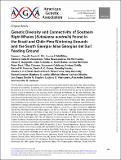Genetic diversity and connectivity of southern right whales (Eubalaena australis) found in the Brazil and Chile–Peru wintering grounds and the South Georgia (Islas Georgias del Sur) feeding ground
Abstract
As species recover from exploitation, continued assessments of connectivity and population structure are warranted to provide information for conservation and management. This is particularly true in species with high dispersal capacity, such as migratory whales, where patterns of connectivity could change rapidly. Here we build on a previous long-term, large-scale collaboration on southern right whales (Eubalaena australis) to combine new (nnew) and published (npub) mitochondrial (mtDNA) and microsatellite genetic data from all major wintering grounds and, uniquely, the South Georgia (Islas Georgias del Sur: SG) feeding grounds. Specifically, we include data from Argentina (npub mtDNA/microsatellite = 208/46), Brazil (nnew mtDNA/microsatellite = 50/50), South Africa (nnew mtDNA/microsatellite = 66/77, npub mtDNA/microsatellite = 350/47), Chile–Peru (nnew mtDNA/microsatellite = 1/1), the Indo-Pacific (npub mtDNA/microsatellite = 769/126), and SG (npub mtDNA/microsatellite = 8/0, nnew mtDNA/microsatellite = 3/11) to investigate the position of previously unstudied habitats in the migratory network: Brazil, SG, and Chile–Peru. These new genetic data show connectivity between Brazil and Argentina, exemplified by weak genetic differentiation and the movement of 1 genetically identified individual between the South American grounds. The single sample from Chile–Peru had an mtDNA haplotype previously only observed in the Indo-Pacific and had a nuclear genotype that appeared admixed between the Indo-Pacific and South Atlantic, based on genetic clustering and assignment algorithms. The SG samples were clearly South Atlantic and were more similar to the South American than the South African wintering grounds. This study highlights how international collaborations are critical to provide context for emerging or recovering regions, like the SG feeding ground, as well as those that remain critically endangered, such as Chile–Peru.
Citation
Carroll , E L , Ott , P H , McMillan , L F , Galletti Vernazzani , B , Neveceralova , P , Vermeulen , E , Gaggiotti , O E , Andriolo , A , Baker , C S , Bamford , C , Best , P , Cabrera , E , Calderan , S , Chirife , A , Fewster , R M , Flores , P A C , Frasier , T , Freitas , T R O , Groch , K , Hulva , P , Kennedy , A , Leaper , R , Leslie , M S , Moore , M , Oliveira , L , Seger , J , Stepien , E N , Valenzuela , L O , Zerbini , A & Jackson , J A 2020 , ' Genetic diversity and connectivity of southern right whales ( Eubalaena australis ) found in the Brazil and Chile–Peru wintering grounds and the South Georgia (Islas Georgias del Sur) feeding ground ' , Journal of Heredity , vol. 111 , no. 3 , pp. 263-276 . https://doi.org/10.1093/jhered/esaa010
Publication
Journal of Heredity
Status
Peer reviewed
ISSN
0022-1503Type
Journal article
Description
This work was supported by the EU BEST 2.0 medium grant 1594 and UK DARWIN PLUS grant 057 and additional funding from the World Wildlife Fund GB107301. The collection of the Chile–Peru sample was supported by the Global Greengrants Fund and the Pacific Whale Foundation. The collection of the Brazilian samples was supported through grants by the Brazilian National Research Council to Paulo H. Ott (CNPq proc. n° 144064/98-7) and Paulo A.C. Flores (CNPq proc. n° 146609/1999-9) and with support from the World Wildlife Fund (WWF-Brazil). The collection of the South African samples was supported by the Global Greengrants Fund, the Pacific Whale Foundation and Charles University Grant Agency (1140217). E.L.C. was partially supported by a Rutherford Discovery Fellowship from the Royal Society of New Zealand. This study forms part of the Ecosystems component of the British Antarctic Survey Polar Sciences for Planet Earth Programme, funded by the Natural Environment Research Council.Collections
Items in the St Andrews Research Repository are protected by copyright, with all rights reserved, unless otherwise indicated.

